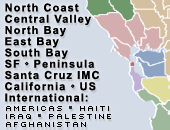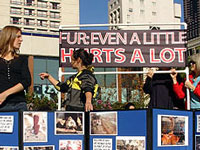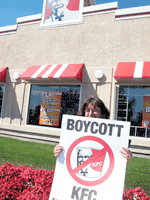Feature Archives
It appears that some 10,000 companion animals did survive. Animal advocates are asking for people to notify gulf coast residents and displaced people that there are now several resources that they can use to search for their pets..
Read resources and tips for finding animals
IDA's Fur Kills.org | PETA's Fur Is Dead.org
HSUS's Still a Jungle Out There | EBAA's California Turkey Industry
Recent Holiday-related News: 1 | 2 | 3
Indybay's 2004 Coverage of Thanksgiving
When the animal rights movement began widely focusing on farmed animals in the 1980s, it wisely chose the veal industry as a primary target. Images of baby cows locked in tiny crates spoke volumes, and most consumers were rightly appalled when they learned of the cruelties these male calves endured. As the public’s taste turned away from veal, countless restaurants dropped it from their menus, and, although the anti-veal campaign continues, their initial success buoyed animal protectionists to further action. It is not a stretch to say that the culinary extravagance known as foie gras, the “fatty liver” of male ducks and geese, is this decade’s veal. As with veal, foie gras is created by grossly manipulating an animal’s body—in this case the Moulard duck—to provide a fleeting gustatory pleasure to the palate. And like their bovine counterparts, the birds being exploited for their livers have activists around the globe championing their cause. More than a dozen countries have outlawed foie gras production, and last year, animal advocates sponsored a California bill that will ban the production and sale of the delicacy in that state in 2012. Similar legislation is pending in New York, Massachusetts, Illinois, and Oregon. Read Full Article
In Santa Cruz, The Progressive Animal Rights Alliance chose to mark the day by demonstrating at the Kentucky Fried Chicken on Mission Street in an ongoing effort to draw attention to KFC's refusal to implement guidelines developed by its own animal welfare panelists for the treatment of the almost 800,000,000 chickens it processes every year. About a dozen activists handed out informational flyers to passing motorists and customers entering and leaving the fast-food restaurant. One KFC employee showed her displeasure with the demonstration by flipping the bird to the demonstrators and the outlet's manager kicked one activist in front of customers and another witness. Full Report with Audio and Photos
PETA's Ongoing Kentucky Fried Cruelty Campaign
Check Indybay's Animal Liberation Calendar for Future Local Events
Previous Indybay Coverage: 1 | 2 | 3 | 4 | 5 | 6
Previous Indybay Coverage of UCSF Animal Issues and Demos: 1 | 2 | 3










